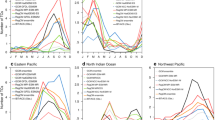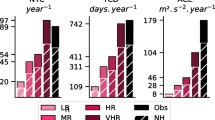Abstract
The characteristics of tropical cyclones (TCs) over the Central America Coordinated Regional Downscaling Experiment (CORDEX) domain are examined for present and future climate conditions using the regional climate model RegCM4. RegCM4 is first tested in a 22 year (1982–2003) simulation with boundary forcing from the ERA-Interim reanalysis, showing a generally good performance in reproducing the observed TC climatology and over the Atlantic in reproducing the interannual variations of TC counts. Four scenario simulations (1970-2100) are generated using two model configurations and two driving global models (MPI and HadGEM). The simulations employing the Grell convection scheme produce too few TCs, while those using the Emanuel convection scheme reproduce the observed climatology, especially when driven by the MPI global model. The simulation of TCs is thus sensitive to both the model convection scheme and the forcing GCM. Comparison of future and present day TC statistics indicates that the frequency of future TCs decreases over the tropical Atlantic and the East Pacific coastal areas while it increases over the western areas of the East Pacific and the northern areas of the Atlantic. We also find an increase in the frequency of intense TCs and long lasting TCs, along with a northward shift of TC tracks over the Atlantic. Conclusions on the changes in TC activity are not found to be sensitive to the inclusion of SST thresholds in the detection procedure. These findings




Similar content being viewed by others
References
Bengtsson L, Hodges KI, Esch M, Keenlyside N, Kornblueh L, Luo JJ, Yamagata T (2007) How may tropical cyclones change in a warmer climate. Tellus 59A:539–561
Camargo SJ, Robertson AW, Barnston AG, Ghil M (2008) Clustering of eastern North Pacific tropical cyclone tracks: ENSO and MJO effects. Geochem Geophys Geosyst 9:Q06V05. doi:10.1029/2007GC001861
Camargo SJ (2013) Global and regional aspects of tropical cyclone activity in the CMIP5 models. J Clim in press, doi:10.1175/JCLI-D-12-00549.1
Collins WJ, Bellouin N, Doutriaux-Boucher M, Gedney N, Halloran P, Hinton T, Hughes J, Jones C D, Joshi M, Liddicoat S, Martin G, O’Connor F, Rae J, Senior C, Sitch S, Totterdell I, Wiltshire A, Woodward S (2011) Development and evaluation of an Earth-System model-HadGEM2. GMD 4:1051–1075. doi:10.5194/gmd-4-1051-2011g
Dee DP, Co-authors (2011) The ERA-Interim reanalysis: configuration and performance of the data assimilation system. Q J R Meteorol Soc 137:553–597. doi:10.1002/qj.828
Dickinson R, Henderson-Sellers A, Kennedy P (1993) Biosphere-atmosphere transfer scheme (bats) version 1e as coupled to the ncar community model. In: NCAR Technical report. TN-387+STR:NCAR, Boulder, CO, p. 72
Diro GT, Rauscher SA, Giorgi F, Tompkins AM (2012) Sensitivity of seasonal climate and diurnal precipitation over Central America to land and sea surface schemes in RegCM4. Clim Res 52:31–48
Emanuel K (1991) A scheme for representing cumulus convection in large scale models. J Atmos Sci 48:2313–2335
Emanuel KA (1987) The dependence of hurricane intensity on climate. Nature 326:483–485
Emanuel KA (2006) Climate and tropical cyclone activity: a new model downscaling approach. J Clim 19:4797–4802
Evans JL, Hart RE (2003) Objective indicators of the life cycle evolution of extratropical transition for atlantic tropical cyclones. Mon Weather Rev 131:909–925
Fuentes-Franco R, Coppola E, Giorgi F, Graef F, Pavia EG (2014) Assessment of RegCM4 simulated interannual variability and daily-scale statistics of temperature and precipitation over Mexico. Clim Dyn 42:629–647
Giorgi F, Coppola E, Solmon F, Mariotti L, Sylla M, Bi X, Elguindi N, Diro GT, Nair V, Giuliani G, Cozzini S, Guettler I, O’Brien T, Tawfik A, Shalaby A, Zakey AS (2012) RegCM4: model description and preliminary tests over multiple CORDEX domains. Clim Res 52:7–29
Giorgi F, Jones C, Asrar G (2009) Addressing climate information needs at the regional level: the CORDEX framework. WMO Bull 58(3):175–183
Giorgi F, Marinucci M, Bates G, Canio G (1993) Development of a second generation regional climate model (RegCM2). Part II: Convective processes and assimilation of lateral boundary conditions. Mon Weather Rev 121:2814–2832
Grell G (1993) Prognostic evaluation of assumptions used by cumulus parameterizations. Mon Weather Rev 121:764–787
Hill KA, Lackmann GM (2011) The impact of future climate change on TC intensity and structure: a downscaling approach. J Clim 24:4644–4661
Gray WM (1975) Tropical Cyclone Genesis. Dept. of Atmospheric Science Paper 234, Colorado State University, Fort Collins, CO, p. 121
Holland G (1997) The maximum potential intensity of tropical cyclones. J Atmos Sci 54:2519–2541
Holtslag A, de Bruijn E, Pan HL (1990) A high resolution air mass transformation model for short range weather forecasting. Mon Weather Rev 118:1561–1575
Kiehl J, Hack J, Bonan G, Boville B, Briegleb B, Williamson D, Rasch P (1996) Description of the ncar community climate model (ccm3). In: NCAR Technical report. TN-420+STR: NCAR, Boulder, CO, p. 152
Kim D, Sobel AH, Del Genio AD, Chen Y, Camargo SJ, Yao MS, Kelley M, Nazarenko L (2012) The tropical subseasonal variability simulated in the NASA GISS general circulation model. J Clim 25(13):4641–4659
Knutson TR, McBride JL, Chan J, Emanuel K, Holland G, Landsea C, Held I, Kossin JP, Srivastas AK, Sugi M (2010) Tropical cyclones and Climate change. Nat Geosci 3:157–163
Knutson TR, Sirutis JJ, Garner ST, Held IM, Tuleya RE (2007) Simulation of the recentmultidecadal increase of atlantic hurricane activity using an 18-km-grid regional model. Bull Am Meteorol Soc 88:1549–1565. doi:10.1175/BAMS-88-10-1549
Knutson TR, Sirutis JJ, Garner ST, Vecchi GA, Held IM (2008) Simulated reduction in Atlantic hurricae frequency under twenty-first-century warming conditions. Nat Geosci 1:359–364
Knutson TR, Tuleya E (2004) Impact of C O 2-induced warming on simulated Hurricane intensity and precipitation: sensistivity to the choice of climate model and convective parameterization. J Clim 17:3477–3495
Knutson TR, Tuleya RE, Kurihara Y (1998) Simulated increase of Hurricane intensities in a C O 2-Warmed Climate. Science 279:1018–1020
Lavender SL, Walsh KJE (2011) Dynamically downscaled simulation of Australian region tropical cyclones in current and future climates. Geophys Res Lett 38:L10705
Murakami H, Mizuta R, Shindo E (2012a) Future Changes in tropical cyclone activity projected by muliti-physics and multi-SST ensemble experiments using the 60km-mesh MRI-AGCM. Clim Dyn 39:2569–2584
Murakami H, Wang B (2010) Future Change of North Atlantic Tropical cyclone tracks: Projection by a 20km-Mesh Global Atmospheric Model. J Clim 23:2699–2721
Murakami H, Wang Y, Yoshimura H, Mizuta R, Sugi M, Shindo E, Adachi Y, Yukimoto S, Hosaka M, Kusunoki S, Ose T, Kitoh A (2012b) Future Changes in tropical cyclone activity projected by the new High-Resolution MRI-AGCM. J Clim 25:3237–3260
Murakami H, Sugi M (2010) Effect of model resolution on tropical cyclone climate projections. SOLA 6(0):73–76
Nguyen KC, Walsh KJE (2001) Interannual, decadal, and transient greenhouse simulation of tropical cyclone-like vortices in a regional climate model of the South Pacific. J Clim 14:3043–3054
Oleson KW, Niu GY, Yang ZL, Lawrence D, Thornton PE, Lawrence P, Stockli R, Dickinson R, Bonan G, Levis S, Dai A, Qian T (2008) Improvements to the Community Land Model and their impact on the hydrological cycle. J Geophys Res 113 (G01021). doi:10.1029/2007JG000563
Oouchi K, Yoshimura J, Yoshimura H, Mizuta R, Kusunoki S, Noda A (2006) Tropical cyclone climatology in global -warming climate as simulated in a 20km-Mesh global atmospheric model: frequency and wind intensity analyses. J Meteorol Soc Jpn 84(2):259–276
Pal JS, Small EE, Eltahir EAB (2000) Simulation of regional-scale water and energy budgets: Representation of subgrid cloud and precipitation processes within RegCM. J Geophys Res 105(D24):29579–29594
Reynolds R, Rayner N, Smith TM, Stokes D, Wang W (2002) An improved in situ and satellite SST analysis for climate. J Clim 15:1609–1625
Semmler T, Varghese S, McGrath R, Nolan P, Wang S, Lynch P, O’Dowd C. (2008) Regional Climate model simulations of North Atlantic cyclones: frequency and intensity changes. Clim Res 36:1–16
Sheffield J, Camargo SJ, Fu R, Hu Q, Jiang X, Johnson N, Karnauskas KB, co authors (2013) North American climate in CMIP5 experiments. Part II: evaluation of 20th century intra-seasonal to decadal variability. J Clim..: submitted.
Stowasser M, Wang Y, Hamilton K (2007) Tropical Cyclone changes in the Western North Pacific in a Global warming Scenario. J Clim 20:2378–2396
Sugi M, Murakami H, Yoshimura J (2009) A reduction in global tropical cyclone frequency due to global warming. Sola 5(0):164–167
Taylor KE, Stouffer RJ, Meehl GA (2012) An overview of CMIP5 and the experimental design. Bull Am Meteorol Soc 93:485–498
Vecchi GA, Soden BJ (2007) Increased tropical Atlantic wind shear in model projections of global warming. Geophys Res Lett 34(8):L08702
Villarini G, Vecchi GA (2012) North Atlantic power dissipation index (PDI) and accumulated cyclone energy (ACE): statistical modeling and sensitivity to sea surface temperature change. J Clim 25:625–637
Villarini G, Vecchi GA (2012) Twenty-first-century projections of North Atlantic tropical storms from CMIP5 models. Nat Clim Chang 2(8):604–607
Villarini G, Vecchi GA, Knutson TR, Zhao M (2011) North Atlantic tropical storm frequency response to anthropogenic forcing: projections and sources of uncertainty. J Clim 24(13):3224–3238
Walsh KJE, Nguyen KC, McGregor JL (2004) Fine-resolution regional climate model simulations of the impact of climate change on tropical cyclones near Australia. Clim Dyn 22:47–56
Walsh KJE, Ryan BF (2000) Tropical cyclone intensity increase near australia as a result of climate change. J Clim 13:3029–3036
Wehner MF, Bala G, Duffy P, Mirin AA, Romano R (2010) Towards direct simulation of future tropical cyclone statistics in a high-resolution global atmospheric model. Adv Meteorol:1–13. doi:10.1155/2010/915303
Yoshimura J, Sugi M, Noda A (2006) Influence of greenhouse warming on tropical cyclone frequency. J Meteorol Soc Jpn 84(2):405–428
Zanchettin D, Rubino A, Matei D, Jungclaus JH (2013) Multidecadal-to-centennial SST variability in the MPI-ESM simulation ensemble for the last millennium. Clim Dyn 40(5):1301–1318. doi:10.1007/s00382-012-1361-9
Zeng X, Beljaars A (2005) A prognostic scheme of sea surface skin temperature for modeling and data assimilation. Geophys Res Lett 32 (L14605)
Acknowledgments
This work has been partially funded by the Project NextData of the Italian Ministry for Education, University and Research, and the Italian Ministry of Environment, Land and Sea.
Author information
Authors and Affiliations
Corresponding author
Additional information
This article is part of a Special Issue on “The Phase I CORDEX RegCM4 Experiment MAtrix (CREMA)” edited by Filippo Giorgi, William Gutowski, and Ray W. Arritt.
Electronic supplementary material
Below is the link to the electronic supplementary material.
Rights and permissions
About this article
Cite this article
Diro, G.T., Giorgi, F., Fuentes-Franco, R. et al. Tropical cyclones in a regional climate change projection with RegCM4 over the CORDEX Central America domain. Climatic Change 125, 79–94 (2014). https://doi.org/10.1007/s10584-014-1155-7
Received:
Accepted:
Published:
Issue Date:
DOI: https://doi.org/10.1007/s10584-014-1155-7




